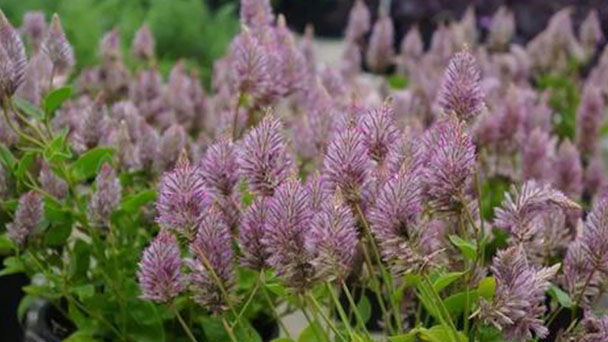Ptilotus plant (Ptilotus exaltatus) profile
Written by Maggie
Apr 22 2021

Ptilotus plant is a one or two year grass flower. It belongs to the Pruxtail genus of Amaranthus family, which has over one hundred varieties and is originally produced in Australia. The flowers are deep aeg iron pink with a dazzling silver edge. They are visually striking and have a long flowering period in Ptilotus Plant.
Ptilotus plant picture

Ptilotus plant info
| Botanical Name | Ptilotus exaltatus |
| Common Names | Ptilotus, Pink Mulla Mulla, Tall Mulla Mulla |
| Plant Type | Annual/Perennial |
| Sun | Full sun |
| Hardiness Zones | 2-11 |
| Flower color | Pink |
| Native Area | Australia |
| Mature size | 1-3 feet |
Ptilotus plant morphological characteristics
One or two years old grass flowers, Ptilotus plant is height 30~40cm, silver green leaves, large flowers, panicles, 7~10cm flower spikes, deep neon peach, gorgeous [1].
Plant height is 30~40cm, conical inflorescences, 7~10cm panicles.Yang, heat resistance, drought resistance, wide adaptability.
Ptilotus plant growing environment
Ptilotus plant is light - loving, temperature - loving, heat - resistant, drought - resistant, wide adaptability, suitable for flower beds or garden planting, potted combination is better.
How to grow and care for Ptilotus plant
Light
The ptilotus plant requires full solar to survive. It must get hold of at least six to eight hours of direct solar for the high-quality growth.
Water
These are in reality drought-tolerant plants. The ptilotus will not often require watering, with the exception of extreme drought-like conditions.
Soil
The ptilotus plant will develop nice in well-drained, lean and free soil (it can additionally be sandy). This have to be amended to the best developing prerequisites with natural count earlier than planting.
Temperature and Humidity
These warm-weather flowers are ideal for everyone who lives in a hot, dry climate, and they are frequently grown in the Mediterranean, tropic or subtropical desert, or in temperate climates. Protection from heavy frost is crucial, specially for youthful ptilotus plants.
Fertilizer
The ptilous exaltatus is regarded to be a pretty low-maintenance plant and does not always want any extra fertilization (provided it used to be planted in average- to-good-quality soil in the first place). However, a general-purpose fertilizer can be used to motivate quicker growth.
Pruning
The flora on a ptilotus exaltatus can have a tendency to show up ragged as the plant receives older. This trouble can be addressed by way of deadheading any spent, dwindled blossoms to motivate new increase and make your plant appear greater attractive.

How to grow Ptilotus plant in Containers
The ptiolotus plant can additionally be grown in containers crammed with well-drained soil. You'll simply favor to be certain the soil dries out definitely between every watering.
Since the ptilotus tends to develop giant (and can nearly show up weed-like) in its herbal environment, greater compact types have been developed that can be used for planting in each containers and gardens.
Propagating Ptilotus
The ptilotus exaltatus can typically be propagated by seed. Its prolific flowering dependancy and early transition from vegetative to reproductive boom from time to time makes it tough to effectively propagate this plant via cuttings. However, it can be done--just be certain you are trying to propagate in the warmest phase of the year, ideally with the best possible humidity.
Other Ptilotus Varieties
Of all the Ptilotus varieties, the exaltatus is recognised for being rarer, taller and barely greater challenging to grow. Some of the different sorts include:
Ptilous nobilis: Known for its soft, flowing flowers
Ptilous manglesii: Attractive rose-color tipped flowers
Ptilous spathulatus: Often used as a groundcover
Ptilotus plant main value
Ptilotus Plant can be used for potted plants, flower beds and garden flower borders.
Excellent for combination potted plants, Ptilotus plants are heat resistant, dry resistant and adaptable, making them focal points for flower beds and landscapes in the hot summer months.Large, hairy flowers bloom on silver-green leaves, and the eye is occasionally attracted by the conical heads of deep neon-peach flowers that shine silver. Ptilotus plant can be a small potted, combined potted, garden flowers. To bloom early, plant Ptilotus plant indoors in a warm place in the middle of winter, and plant outdoors 6 to 8 weeks later (after late spring is frost-free).

Latest Updated
- Benefits of Bugleweed - 7 Science-backed Health Benefits
- Bugleweed Dangers & Side Effects - Is It Poisonous?
- How to Plant Evergreen Trees - What You Should Know
- When to Plant Evergreens - Grow Guide for Evergreen Trees
- 12 Wonderful Evergreen Shrubs for Your Garden
- 12 Popular Evergreen Plants with Pictures for Beginners
- When And How To Prune A Lilac Bush Like a Pro
- How to Grow & Care for Lilac Vine (Hardenbergia Violacea)
- Japanese Lilac Tree (Syringa Reticulata) Care & Propagation Guide
- Shumard Oak Pros and Cons - What to Know
Popular Articles
- Winter maintenance of Antirrhinum Majus
- How to Grow Terminalia Mantaly Tree
- How to Grow and Care for Crossostephium Chinense
- How to grow Antirrhinum Majus in spring
- Peristeria Elata (Dove Orchid) Profile: Info & Care Guide
- Underwatered Snake Plant (Sansevieria Trifasciata) - Signs And How To Fix
- How to Care for Brazilian Jasmine Plant (Mandevilla Sanderi)
- How to Grow & Care for Graptopetalum Purple Delight in Summer
- Rosa Chinensis (China Rose): Plant Growing & Care Tips
- How to Care for Baby Sun Rose (Aptenia Cordifolia)